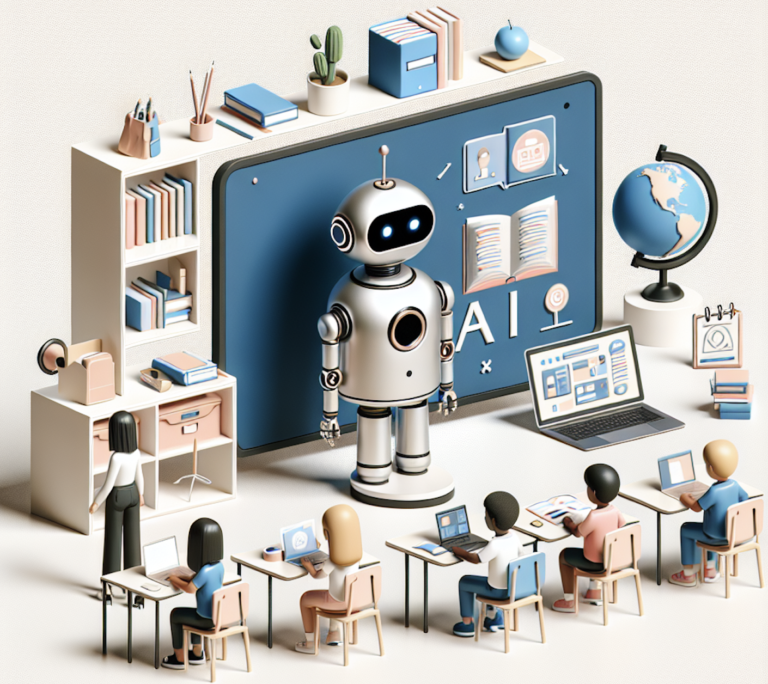The Modern Teaching Dilemma
Teaching poses significant challenges, particularly in addressing the diverse needs of every student in the classroom. Envision a scenario where learning is as unique as each student, yet doesn’t overwhelm educators. Fortunately, technology offers a solution.
The Impact of AI in Education
Artificial Intelligence (AI) is revolutionizing education. This article explores how AI achieves this transformation and presents five practical applications for integrating AI into your educational practice.
The Application of AI in Education
Real-Time Lesson Adjustment
AI empowers teachers to identify when students struggle and require additional assistance. This immediate feedback allows educators to modify lessons promptly to better suit the class’s needs. AI’s instant insights are crucial, enabling teachers to adapt their teaching methods dynamically. This technology significantly enhances classroom management by providing precise assessments during lessons.
Personalized Learning Enhancements
AI tailors learning experiences to individual students. Whether students find the material too challenging or too simple, AI adjusts lesson plans to match their pace and comprehension levels. This adaptive learning approach identifies where students may be struggling and addresses those gaps seamlessly.
Optimizing the Learning Environment
AI plays a vital role in creating conducive learning environments. For instance, ViewSonic’s movie board Sens monitors classroom conditions to ensure optimal settings. It evaluates factors such as lighting and noise levels, enhancing focus for all students. Importantly, it achieves this without compromising privacy.
Boosting Classroom Focus
AI technology minimizes distractions for both students and teachers. By monitoring the classroom environment, AI ensures students can concentrate and perform at their best. It uses data while safeguarding personal information, making classrooms ideal for digital learning and development without privacy concerns.
Supporting Teachers Directly
Beyond enhancing the learning environment, AI provides direct support to teachers by automating repetitive tasks. This frees up time for educators to focus on their students and lesson planning. AI tools like Top Hat, Education Copilot, and ChatGPT streamline lesson planning and create personalized learning paths for students with special needs. This support ensures every student receives the attention they need to succeed.
Reducing Teacher Workload
AI simplifies the myriad responsibilities teachers face, decreasing the amount of work required outside of teaching hours. This shift allows teachers to prioritize student interaction over administrative tasks. With a reduced workload, teaching becomes more about guiding students rather than managing paperwork.
Streamlining Lesson Planning
AI tools such as MagicSchool.ai and ChatGPT revolutionize lesson planning by making it more efficient. These tools assist in crafting plans that meet lesson objectives and learning activities. What once took hours to prepare can now be accomplished in minutes, allowing more time for teaching and refining lesson plans.
Swift Content Creation with AI
Tools like Canva and Padlet complement AI-generated plans by facilitating quick content creation. The 80/20 approach is essential here: AI handles 80% of the initial work, and teachers fine-tune the content to ensure precision. This blend of technological efficiency and human insight guarantees effective and engaging lessons without consuming excessive time.
Enhancing Teacher-Student Communication
AI has transformed teacher-student interaction. AI ensures every student has a voice, utilizing technologies like speech recognition to aid students with disabilities in participating more actively. This inclusivity makes learning more accessible to all students. Teachers can engage with students individually, even outside classroom hours, using apps and tools that enable constant communication.
Fostering Community Engagement and Critical Thinking
AI projects help students better understand their communities by tackling real-world problems. This approach fosters critical thinking and supports diverse learners, ensuring no student is left behind due to learning styles or disabilities.
5 Practical Ways to Utilize AI in Education
1. Personalized Learning
Personalized learning revolutionizes education by catering to individual student needs. AI assesses each student’s requirements and adjusts lessons accordingly, creating a tailored learning experience. This customization prevents boredom and confusion, ensuring lessons are engaging and appropriately challenging for every student.
2. Efficient Content Creation
AI simplifies content creation for education. Teachers can leverage AI tools to save time and enhance lesson quality. These tools analyze student data to create customized courses that meet individual needs, making learning more effective and personalized.
Integrating PopAi for Presentations
PopAi offers an innovative solution for designing AI-powered presentations (AI PPT) quickly. This tool allows teachers to automate grading tasks and focus more on teaching, reducing the time spent on lesson planning and evaluation.
3. Streamlining Administrative Tasks
AI tools like chatbots and predictive analytics streamline school management by handling routine tasks such as scheduling, grading, and enrollment. This automation reduces administrative burdens, allowing teachers and staff to dedicate more time to student learning.
Smart Resource Management
AI-powered assistants optimize resource management and curriculum development, ensuring that each student’s needs are met through efficient planning and allocation.
4. Advancing Teaching Insights
AI transforms how teachers gain insights and enhance their methods. It provides detailed data on student performance, highlighting the most effective teaching strategies. Teachers can identify which lessons inspire creativity and critical thinking, making it easier to refine their approach for improved outcomes.
Personalized Learning Journeys
By embracing AI, educators can create personalized learning journeys for each student. Real-time analytics enable teachers to adjust their teaching styles, ensuring every student receives the necessary support. This approach not only enhances education but also encourages continuous innovation in teaching methods.
Conclusion
AI enhances education by personalizing lessons, supporting teachers, and making learning more adaptable. It saves time and allows students to progress at their own pace. By integrating AI, educators can simplify tasks and discover new teaching methods. Numerous tools are available to help you start incorporating AI into your classroom. These strategies demonstrate how technology can positively transform education. Let’s harness AI to make every student’s learning journey exceptional.
Keep an eye for more news & updates on Vents buzz!
